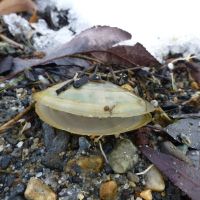Let’s say you are along the river and want to make an important map. To learn how, why not go to Buffalo Eddy on the Snake?

There are patterns here.

Buffalo Eddy has been carved for at least 6,000 years.
There are four triads of circles, two open and two filled, above four circles around each other, which makes five. It is matched to the central circle of the five, which varies the theme into open and closed semi-circles. Note as well that the left circle of the top triad is accompanied by four circles and one waning moon. If there are celestial patterns here (and that’s only an if), the central one could easily be a pair of sun dogs, which would suggest a year made out of equal times periods of light and darkness. But that’s only an “if”. It doesn’t matter what interpretation is laid over this map, because the pattern still holds. In addition to this pattern of circles and power lines (made out of circles), there is an extra line, which leads to a tower of figures, much like a basalt pile, and especially a pair of either cat or owl-shaped shaped figures. This (orange) line leads to a collection of human and humanoid animal figures (the latter with tails…lizards?) at the middle right of the image, one of which holds up the circle opposite tothe circle that balances the crescent moon, and another which touches it with its snout. In addition, the pattern of concentric circles at the bottom of the image (which could be a representation of the entire pattern?) stands above a figure which is a partially-open mouth with two eyes, on a slender stalk, with a bulb-shaped ovoid below it. Note that the bottom two pink triangles, and not the central black triangle above them, anchor the two triangles to right, repeating the four-pattern laterally, and dividing it on a left-right axis (the central column of circles.) There’s a lot else going on here, but that’s a start. It is simultaneously an earthly, celestial, and spiritual map, and a map of human bodies and consciousness across species. The one art-form in Western culture that does all that at once is poetry. The similarities are obvious, and, like poetry, the images are written directly on the land and relate to life lived simultaneously in land and sky. Oh, one more thing. It’s faint, but it’s there:

I Doubt These are Male Patterns
I think that’s about half of what’s there. In all cases, though, they are reading the rock. I mean, this rock was chosen for this most important of designs
Note that it has two ears, and in the left one there is a stag, made out of a fracture, with an upturned crescent moon for antlers. I think if you compare those ears to the Itseyeyeh (coyote…just say it under the moon and you’ll be there with the wild dogs) figures at right, you have the beginning (or end) of an ancient story at least 6,000 years old. If you want to turn the entire face upside down, the crack between the ears becomes the river flowing to its delta and that other delta, a vagina. Whatever the case, there is an angular crack across the rock, at the lower left. The figures do not cross it. Nor do they cross the other cracks to the left and right of the design area. Now, compare to the purple boundary in the map below:

The shape is similar enough to give one pause. Which map of the Nimiipu’u homeland is the most informative? Have a look:

Categories: First Peoples, History, Land, Spirit














What can a pre-colonial map show us about writing post-colonial poetry? A forthcoming blog will speak to this, I hope…
LikeLike
Oh, I thought it was obvious. Thanks for asking.
>
LikeLiked by 1 person